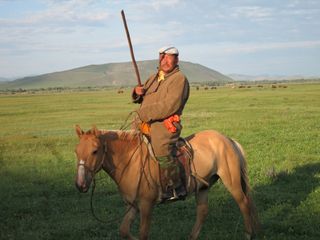Warm, Wet Climate Likely Helped Genghis Khan Conquer the World

A generous stretch of warm, wet weather may have fueled Genghis Khan's wave of expansion through Asia and the Middle East in the 1200s, new research confirms.
The findings, first reported in 2012, have now been published in a peer-reviewed scientific journal, Proceedings of the National Academy of Sciences. By using data from tree rings of Siberian pines, researchers found an unusually warm and wet period between A.D. 1211 and 1225, corresponding with Genghis Khan's horse-driven invasion. The Mongol Empire eventually spanned from what is today Korea to eastern Europe and the Middle East.
The unusual wetness in a typically arid region would have lead to carpets of greenery, perfect food for the half-dozen or more horses kept by every Mongol warrior.
"It must have created the ideal conditions for a charismatic leader to emerge out of the chaos, develop an army and concentrate power," study researcher Amy Hessl, who studies tree rings at West Virginia University, said in a statement. "Where it's arid, unusual moisture creates unusual plant productivity, and that translates into horsepower. Genghis was literally able to ride that wave." [Top 10 Ways Weather Changed History)
Grass-fueled invasion
Genghis Khan was born sometime around A.D. 1160. He was the son of a leader of one of the many autonomous clans that ruled in a fragmented Mongolia at the time. Genghis would unite these clans, subduing and slaughtering those who opposed him. He then launched military expeditions outward from Mongolia, having conquered a huge swath of Asia and the near East by his death in 1227. His descendants would later expand the empire further.
Originally, scientists and historians speculated that the Mongols expanded from their grassy homelands to get away from harsh weather. The new study, led by Neil Pederson, a tree-ring researcher at Columbia University's Lamont-Doherty Earth Observatory, found the opposite.
Sign up for the Live Science daily newsletter now
Get the world’s most fascinating discoveries delivered straight to your inbox.
Pederson, Hessl and their colleagues took wood samples from dead Siberian pines on a lava flow in the Khanghai Mountains of Mongolia. These trees are water-stressed and live close to the edge, so the tree rings record a sensitive timeline of wet and dry seasons.
The oldest rings found dated as far back as 650 B.C. Each ring records a year of growth, with more growth in warm and wet years. By comparing the ring sizes to the rings of modern trees, the researchers found that Mongolia suffered from major drought between 1180 and 1190, before Genghis Khan united the tribes.
From 1211 to 1225, the climate became wet and warm, probably allowing for Genghis' initial military forays.
Modern warnings
The tree rings are less auspicious for modern Mongolia. After centuries of typical dry and cold with periodic fluctuations, the last 40 years of tree ring data point to unprecedented drought. The most recent, which began in 2002 and lasted until 2009, was similar in length and lack of rainfall to the droughts during the chaotic pre-empire times in the 1100s, the researchers reported.
Mongolia has seen extreme warming in the last 40 years, with temperatures increasing 4.5 degrees Fahrenheit (2.5 degrees Celsius) in some regions. In comparison, global average temperatures have risen about 1.4 degrees F (0.8 degrees C), according to NASA's Goddard Institute for Space Studies.
The pine tree ring data shows that the 2002 to 2009 drought was the hottest on record. Summer dryness was followed by dzuds, extremely long and cold winters. The 2009 to 2010 dzud killed some 8 million livestock and created an influx of out-of-work herders to the Mongolian capital of Ulaanbaatar.
These problems are only likely to worsen in the future, according to Pederson.
"This last big drought is an example of what may happen in the future, not just in Mongolia but in a lot of inner Asia," he said in a statement. "The heat is a double whammy — even if rainfall doesn't change, the landscape is going to get drier."
The anthropogenic change highlights another intersection of climate and humanity in Mongolia: An unrelated 2011 study found that the mass death caused by Genghis Khan's conquering forces translated into a slight decrease in global atmospheric carbon dioxide. The Mongol invasion took enough carbon dioxide out of the air as is emitted annually by worldwide gasoline use today, researchers reported in the journal The Holocene. But Genghis' effect is nothing compared to the 100 parts per million increase in carbon dioxide concentration created by humans since the beginning of the Industrial Revolution.
Follow Stephanie Pappas on Twitter and Google+. Follow us @livescience, Facebook & Google+. Original article on Live Science.

Stephanie Pappas is a contributing writer for Live Science, covering topics ranging from geoscience to archaeology to the human brain and behavior. She was previously a senior writer for Live Science but is now a freelancer based in Denver, Colorado, and regularly contributes to Scientific American and The Monitor, the monthly magazine of the American Psychological Association. Stephanie received a bachelor's degree in psychology from the University of South Carolina and a graduate certificate in science communication from the University of California, Santa Cruz.
